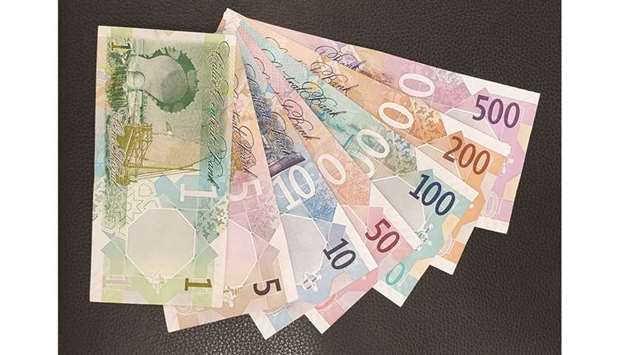Qatari riyal’s peg to dollar will hold as the Qatar Central Bank has large foreign exchange (FX) reserves to support the currency, Allianz Trade said in its country report.
Allianz Trade expects Qatar’s exchange rate stability to be maintained and price stability to be regained in 2022-2023. The Qatari riyal (QAR) is pegged at 3.64 to the dollar.
According to Allianz Trade, the currency peg has ensured relative price stability since 2010. In 2021, however, headline consumer price inflation rose to over 6% year-on-year (y-o-y) at the end of the year owing to base effects (deflation a year earlier), higher energy prices and global supply-chain disruptions.
“We expect these effects to be transitory and inflation to gradually fall back to around 2% at the end of 2022,” Allianz Trade noted.
Qatar’s fiscal reserves are solid but rising public debt requires monitoring, it said.
The country’s fiscal breakeven point has ranged between $35 and $55 per barrel of crude oil over the past decade.
Hence the government has recorded large annual fiscal surpluses in most years, except for 2016-2017 when oil and gas prices had been persistently low for some time. Even in 2020, a small surplus of +1.3% of GDP was achieved.
Allianz Trade estimates the surplus to have widened to around 3% in 2021, thanks to higher gas prices, and project continued robust surpluses in 2022-2023.
Meanwhile, public debt rose from 25% of GDP in 2014 to 72% in 2020, in part due to declining nominal GDP.
“Even though we expect the ratio to decline gradually over 2021-2023 in the wake of the economic recovery, it will remain elevated and should be monitored closely. Overall, however, Qatar will remain a large net external creditor, thanks to the huge foreign-asset position in the Qatar Investment Authority -QIA, a sovereign wealth fund currently estimated at approximately $350bn,” Allianz Trade said.
External liquidity, it said will “remain unproblematic”.
Qatar has recorded large, sometimes huge annual current account surpluses for more than two decades, with the exceptions of 2016 and 2020 when global oil and gas prices were particularly low. These surpluses have contributed to the build-up of the QIA.
Allianz Trade estimates that higher oil and gas prices moved back the current account into a surplus of 5% of GDP or more in 2021 and that ratio should rise further in 2022-2023.
Meanwhile, external debt is relatively high, estimated at around 120% of GDP, incurred by oil and gas investments since the 2000s, but repayment obligations are unlikely to present liquidity problems. The annual debt service-to-export-earnings ratio stands at a moderate 13% or so. Financial resources will remain strong. Combined FX reserves of the central bank and the QIA represent over 200% of annual GDP and cover more than 50 months of imports, Allianz Trade noted.
Allianz Trade expects Qatar’s exchange rate stability to be maintained and price stability to be regained in 2022-2023. The Qatari riyal (QAR) is pegged at 3.64 to the dollar.
According to Allianz Trade, the currency peg has ensured relative price stability since 2010. In 2021, however, headline consumer price inflation rose to over 6% year-on-year (y-o-y) at the end of the year owing to base effects (deflation a year earlier), higher energy prices and global supply-chain disruptions.
“We expect these effects to be transitory and inflation to gradually fall back to around 2% at the end of 2022,” Allianz Trade noted.
Qatar’s fiscal reserves are solid but rising public debt requires monitoring, it said.
The country’s fiscal breakeven point has ranged between $35 and $55 per barrel of crude oil over the past decade.
Hence the government has recorded large annual fiscal surpluses in most years, except for 2016-2017 when oil and gas prices had been persistently low for some time. Even in 2020, a small surplus of +1.3% of GDP was achieved.
Allianz Trade estimates the surplus to have widened to around 3% in 2021, thanks to higher gas prices, and project continued robust surpluses in 2022-2023.
Meanwhile, public debt rose from 25% of GDP in 2014 to 72% in 2020, in part due to declining nominal GDP.
“Even though we expect the ratio to decline gradually over 2021-2023 in the wake of the economic recovery, it will remain elevated and should be monitored closely. Overall, however, Qatar will remain a large net external creditor, thanks to the huge foreign-asset position in the Qatar Investment Authority -QIA, a sovereign wealth fund currently estimated at approximately $350bn,” Allianz Trade said.
External liquidity, it said will “remain unproblematic”.
Qatar has recorded large, sometimes huge annual current account surpluses for more than two decades, with the exceptions of 2016 and 2020 when global oil and gas prices were particularly low. These surpluses have contributed to the build-up of the QIA.
Allianz Trade estimates that higher oil and gas prices moved back the current account into a surplus of 5% of GDP or more in 2021 and that ratio should rise further in 2022-2023.
Meanwhile, external debt is relatively high, estimated at around 120% of GDP, incurred by oil and gas investments since the 2000s, but repayment obligations are unlikely to present liquidity problems. The annual debt service-to-export-earnings ratio stands at a moderate 13% or so. Financial resources will remain strong. Combined FX reserves of the central bank and the QIA represent over 200% of annual GDP and cover more than 50 months of imports, Allianz Trade noted.


